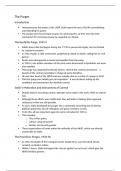The Purges
Introduction
Having become the leader of the USSR, Stalin spent the rest of his life consolidating
and extending his power.
The purges were his principal weapon for achieving this, as they were his chief
mechanism for removing anyone he regarded as a threat.
The Ryutinite Purge, 1933-4
Public show trials had begun during the 1st FYP to persecute largely, but not limited
to, industrial enemies.
In 1932, Ryutin, a right communist, published an attack on Stalin, calling him an ‘evil
genius’.
Ryutin was subsequently arrested and expelled from the party.
In 1933-4, one million members of the party were denounced as Ryutinites and were
also expelled.
This purge was organised by Nicolai Yeshov, chief of the control commission – a
branch of the central committee in charge of party discipline.
He was later head of the NKVD and was actually shot as a victim of a purge in 1940.
This first purge was initially just part expulsion – it was all about setting up the
conditions and mechanisms for absolute control.
Stalin’s Motivation and Instruments of Control
Despite Stalin’s increasing control, attempts were made in the early 1930s to criticise
him.
Although these efforts were ineffectual, they led Stalin to believe that organised
resistance to him was still possible.
As such, Stalin developed the purges into a systematic terrorising not of obvious
political opponents, but of colleagues and party members as well.
To do this, all law enjoyment agencies were centralised in 1933-4.
This included:
o The civilian police
o Labour camp personnel
o Border and security guards.
These organisations all came under the authority of the NKVD, which was directly
answerable to Stalin.
The Post-Kirov Purges, 1934-36
In 1934, the leader of the Leningrad soviet, Sergei Kirov, was shot dead almost
certainly on Stalin’s orders.
Within 2 hours, Stalin had signed the ‘decree against terrorist acts’ which gave the
NKVD limitless powers.
, People were removed (executed or exiled), and their positions were filled by
Stalinists.
There were high status victims in this purge, proving that no one was safe.
This marked the beginning of arbitrary arrests and summary executions.
An outline of what happened
Kirov was shot by Leonid Nikolaev, the reason being that Kirov had had an affair with
Nikolaev’s wife.
However, the shooting was most likely supported, if not planned, by Stalin himself.
Whatever Stalin’s involvement, the murder worked directly to his advantage.
Kirov had been unhappy with the speed and scale of industrialisation and was
against extreme measures being used as a means of disciplining party members.
He was also extremely popular.
Thus, if organised opposition was to form within the party, Kirov might have acted as
a ringleader.
Within two hours of his death, Stalin had signed a decree against terrorist acts, and
on the pretext of hunting down the killers, a purge of party began.
o 3000 suspected conspirators were rounded up and were then imprisoned or
shot.
o 10s of thousands were deported from Leningrad.
o Stalin filled the vacant positions with his own supporters, meaning that there
was no longer any area of the Soviet bureaucracy that Stalin did not control.
Many victims of the purge had been high standing communist members, such as
Kamenev and Zinoviev.
Summary execution became the norm.
o 1996 delegates attended the party Congress in 1934 – 1108 were arrested.
The Stalin Enrolment, and how did it Help?
Between 1931 and 34, the party had recruited an extremely high number of skilled
workers and industrial managers.
These people owed their privileged positions directly to Stalin's patch niche, and
they were acutely aware of this.
As such, the new members eagerly supported the elimination of the anti-Stalin and
elements of the party.
This improved their own chances promotion as well, as jobs were scarce and
denouncing other members resulted in less competition.
What were the Main Consequences of the post-Kirov Purge?
Stalin controlled all of the Soviet bureaucracy.
Party members feared for the further jobs and lives.
The Great Purge, 1936-38 – the Start of the Great Terror




